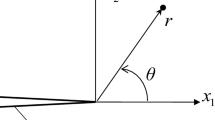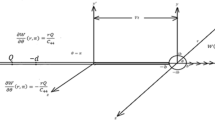Abstract
Hodograph transformations can be used to linearize a nonlinear partial differential equation by judicious use of physical quantities (e.g. velocities or displacement gradients) as coordinate variables in the hodograph plane. This approach has been found useful for obtaining the leading order terms of eigenproblems that govern asymptotic singular crack fields in nonlinear materials. There is little work on the use of the hodograph transformation for obtaining higher order terms in the asymptotic expansion of the crack tip fields. In this paper, we develop a framework to obtain such higher order terms using the hodograph transformation. The method relies heavily on the representation of physical quantities of interest in terms of hodograph plane variables. We demonstrate the method via application to a generalized neo-Hookean material. In addition, asymptotic path-independent J-integrals are expressed in terms of either physical or hodograph variables and are used to compute the leading-order amplitude coefficients. A relationship between the asymptotic J-integrals and the energy release rate is established for a mixed crack mode. The asymptotic results are compared with numerical results from finite element computation and excellent agreement is obtained.







Similar content being viewed by others
References
Chaplygin SA (1904) On gas jets. Sci Ann Imp Univ Mosc Phys Math Div, p 21
Courant R, Friedrichs KO (1948) Supersonic flow and shock waves. Interscience, New York
Courant R, Hilbert D (2008) Methods of mathematical physics: partial differential equations. Wiley, Hoboken
Craggs JW (1948) The breakdown of the hodograph transformation for irrotational compressible fluid flow in two dimensions. Math Proc Camb Philos Soc 44:360–379. https://doi.org/10.1017/S0305004100024373
Geubelle PH, Knauss WG (1994) Finite strains at the tip of a crack in a sheet of hyperelastic material: I. Homogeneous case. J Elast 35:61–98. https://doi.org/10.1007/BF00115539
Knowles JK (1977) The finite anti-plane shear field near the tip of a crack for a class of incompressible elastic solids. Int J Fract 13:611–639. https://doi.org/10.1007/BF00017296
Knowles JK, Sternberg E (1983) Large deformations near a tip of an interface-crack between two Neo-Hookean sheets. J Elast 13:257–293. https://doi.org/10.1007/BF00042997
Knowles JK, Sternberg E (1974) Finite-deformation analysis of the elastostatic field near the tip of a crack: Reconsideration and higher-order results. J Elast 4:201–233. https://doi.org/10.1007/BF00049265
Knowles JK, Sternberg E (1973) An asymptotic finite-deformation analysis of the elastostatic field near the tip of a crack. J Elast 3:67–107. https://doi.org/10.1007/BF00045816
Knowles JK, Sternberg E (1981) Anti-plane shear fields with discontinuous deformation gradients near the tip of a crack in finite elastostatics. J Elasticity 11:129–164. https://doi.org/10.1007/BF00043857
Koskinen MF (1963) Elastic-plastic deformation of a single grooved flat plate under longitudinal shear. J Basic Eng 85:585–591. https://doi.org/10.1115/1.3656914
Li FZ, Shih CF, Needleman A (1985) A comparison of methods for calculating energy release rates. Eng Fract Mech 21:405–421. https://doi.org/10.1016/0013-7944(85)90029-3
Lighthill MJ, Goldstein S (1947) The hodograph transformation in trans-sonic flow. I. Symmetrical channels. Proc R Soc Lond Ser Math Phys Sci 191:323–341. https://doi.org/10.1098/rspa.1947.0118
Liu Y, Moran B (2021a) Effects of multiple families of nonlinear fibers on finite deformation near a crack tip in a hyperelastic sheet
Liu Y, Moran B (2021b) Crack tip fields in a neo-Hookean sheet reinforced by nonlinear fibers. J Mech Phys Solids 152: 104406. https://doi.org/10.1016/j.jmps.2021.104406
Liu Y, Moran B (2020a) Asymptotic path-independent integrals for the evaluation of crack-tip parameters in a neo-Hookean material. Int J Fract 224:133–150. https://doi.org/10.1007/s10704-020-00452-4
Liu Y, Moran B (2020b) Large deformation near a crack tip in a fiber-reinforced neo-Hookean sheet. J Mech Phys Solids 143:104049. https://doi.org/10.1016/j.jmps.2020.104049
Long R, Hui C-Y (2011) Effects of finite chain extensibility on the stress fields near the tip of a mode III crack. Proc R Soc Math Phys Eng Sci 467:3170–3187. https://doi.org/10.1098/rspa.2011.0229
Long R, Krishnan VR, Hui C-Y (2011) Finite strain analysis of crack tip fields in incompressible hyperelastic solids loaded in plane stress. J Mech Phys Solids 59:672–695. https://doi.org/10.1016/j.jmps.2010.12.005
Long R, Hui C-Y, Gong JP, Bouchbinder E (2021) The fracture of highly deformable soft materials: a tale of two length scales. Annu Rev Conden Matter Phys 12. https://doi.org/10.1146/annurev-conmatphys-042020-023937
Moran B, Shih CF (1987) Crack tip and associated domain integrals from momentum and energy balance. Eng Fract Mech 27:615–642. https://doi.org/10.1016/0013-7944(87)90155-X
Ravichandran G, Knauss WG (1989) A finite elastostatic analysis of bimaterial interface cracks. Int J Fract 39:235–253. https://doi.org/10.1007/BF00047452
Rice JR (1968) A path independent integral and the approximate analysis of strain concentration by notches and cracks. J Appl Mech 35:379–386. https://doi.org/10.1115/1.3601206
Rice JR (1967) Stresses due to a sharp notch in a work-hardening elastic–plastic material loaded by longitudinal shear. J Appl Mech 34:287–298. https://doi.org/10.1115/1.3607681
Rice JR (1966) Contained plastic deformation near cracks and notches under longitudinal shear. Int J Fract Mech 2:426–447. https://doi.org/10.1007/BF00183821
Shih CF, Moran B, Nakamura T (1986) Energy release rate along a three-dimensional crack front in a thermally stressed body. Int J Fract 30:79–102. https://doi.org/10.1007/BF00034019
Author information
Authors and Affiliations
Corresponding author
Additional information
Publisher's Note
Springer Nature remains neutral with regard to jurisdictional claims in published maps and institutional affiliations.
Appendix A: Solution of higher order eigenmodes of a GNH material
Appendix A: Solution of higher order eigenmodes of a GNH material
Here, we show that the first three order eigenmodes in Eq. (67) obtained by the hodograph transformation are the same as those in (Geubelle and Knauss 1994). We start with the first order eigenmode given by
where
To obtain Eq. (A.1) from \((m_{1} -1)C_{1} R^{m_{1} }\cos \vartheta \) in Eq. (65), we need to use Eq. (69) and following relations
and
Using these relations, we can further show
and
From the above relations, it can be shown that the square of the first order eigenmode of y becomes
where
It can be verified that \(f_{1} (\theta ;\;n)\) is the same as the expression given in Eq. (A.1), and p reduces to \(p=2C_{1}^{\tfrac{1}{2}} \) for \(n=1\), i.e., Eq. (50).
To obtain the higher order eigenmodes, we can first show that
and
where \(\cos \zeta \) is an intermediate variable in the coordinate transformation (Knowles and Sternberg 1974; Geubelle and Knauss 1994). Thus, using Eqs. (A.6), (A.10) and (A.11), we obtain the second order eigenmode
where
Equation (A.12) is the same as Eq. (4.22) in (Geubelle and Knauss 1994). In a similar way, we can show shat the third order eigenmode in the physical plane satisfies
where
Equation (A.14) is the same as Eq. (3.35) in (Geubelle and Knauss 1994). Thus, we show that all the three (and beyond, if desired) eigenmodes can be obtained by the hodograph transformation.
Rights and permissions
About this article
Cite this article
Liu, Y., Moran, B. Hodograph transformation for crack-tip fields in hyperelastic sheets: higher order eigenmodes and asymptotic path-independent integrals. Int J Fract 229, 77–94 (2021). https://doi.org/10.1007/s10704-021-00542-x
Received:
Accepted:
Published:
Issue Date:
DOI: https://doi.org/10.1007/s10704-021-00542-x




